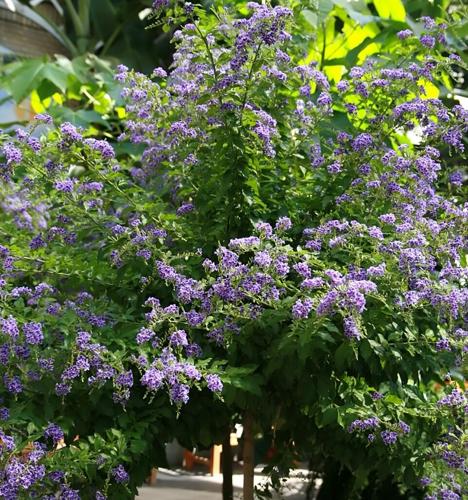Garden columnist Dan Gill answers readers' questions each week. To send a question, email Gill at gnogardening@agcenter.lsu.edu.
I have a well-established duranta plant about 5 feet tall. As a result of the freeze, the canopy looks like it has died. Should I prune it below the canopy in hopes that it comes back, leave it alone or cut it down to a few inches above the ground? Also, what would be the best way to protect it in the future? — Jay Harney
You may simply leave your cold-damaged duranta (Duranta erecta) alone and wait until spring when, hopefully, you will see new growth sprouting from still-living parts in the lower portions of the plant. When you see new growth in the spring, you will be able to clearly see what has survived the winter (sprouting) and what has not (not sprouting) and then prune with confidence to remove the dead growth.
Or you can try and determine what is dead and prune now. This would make the plant smaller and easier to cover should we have additional severe freezes.
Starting high in the plant, use your thumbnail to scratch the bark. If the tissue right under the bark is tan or brown, it is dead. Continue to work your way down the plant scratching the bark. When you hit sections that are green, that’s where the plant is still alive. You can prune off the dead top parts back to the parts you have determined are still alive.
If you need to protect it again this winter, cover the entire plant, with the cover reaching the ground, and weight the edges with bricks or rocks or soil to seal in the warmth.
Is it OK to apply fallen leaves under trees as a mulch? We spread raked leaves under a tree in our front yard. Do I need to mow them first to chop them up? Also, I've read that the leaf mulch should extend out to the drip line of the trees. Do you agree? — Cathy
Having leaves under the tree is not just OK, it is perfectly natural and healthy for the tree, and there is no need to chop them with a mower (although you certainly may).
Think about it: In the wild, the leaves a tree drops land underneath it and stay there to decay. You will simply be creating a natural situation that the tree will appreciate.
The mulch can extend as far out from the trunk as you like. Extending it to the drip line is excellent if you don’t have lawn grass growing there.
Generally, mulches under trees should be no deeper than 6 inches. Pull the mulch slightly back from the trunk of the tree.

Poinsettias purchased for this holiday season can be planted into the landscape, but don't feel bad if you just want to compost them instead.
I bought several beautiful poinsettias for Christmas. It seems a shame to throw them away. Can I plant them in my yard? — Gretchen Wilson.
I get this question just about every year around this time. First, don’t plant poinsettias in your landscape just because you have them. I generally discard my poinsettias after the holidays. They go into the compost pile, and I don’t feel a bit guilty. I think of these plants as temporary decorations like flower arrangements.
They can, however, be planted in the landscape and provide years of beauty. If there is a spot where you think a poinsettia would look good and fit in well with the existing landscape, go ahead and plant it.
The time to plant poinsettias outside is late March or April after danger of frost has passed. Until then keep your plants in a sunny window and water when the soil begins to feel dry.
Cut the plant back about halfway just prior to planting. Plant your poinsettias in a sunny, well-drained location protected from north winds and frost (the south side of a house works well). Make sure the location receives no artificial light at night as this can prevent poinsettias from blooming.
Garden tips
VEGGIES NOW: Vegetables to plant in January include beets, broccoli, cabbage, carrots, cauliflower, Chinese cabbage, collards, kale, kohlrabi, lettuce, mustard, radishes, shallots, snow peas, spinach, Swiss chard and turnips. Plant seeds of tomatoes, peppers and eggplants in greenhouses or under lights indoors in late January to produce transplants to be planted out in March.
KILLING PESTS: Only use garden pesticides when the problem has been properly identified and they are absolutely necessary. There is no need to spray an insecticide, for instance, every time you see a bug or minor damage. When a pesticide is recommended, always ask for the least toxic product that will do the job.
WARM WATERING: During the cold winter weather, the water coming out of the tap can be decidedly chilly. When filling up your watering can to water your indoor plants, don’t just turn on the cold-water tap. Turn on both cold and hot water and adjust the temperature until it feels tepid or barely warm. This is healthier for tropical houseplants and will prevent the spotting of African violet foliage.
KEEP MOWING: Regularly mow lawns overseeded with ryegrass at a height of 1½ inches to keep them looking attractive.
ONGOING BLOOMS: Petunias, snapdragons and other cool-season bedding plants may bloom less during the mid-winter period but should pick up again in the late winter and early spring. If the foliage color is a good deep green and the plants seem to be growing well, you shouldn’t need to fertilize now.



